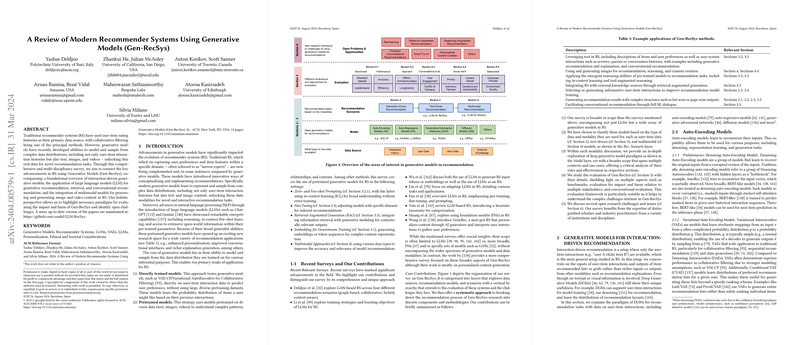A Review of Modern Recommender Systems Using Generative Models (Gen-RecSys)
This manuscript presents an in-depth survey of the integration of generative models within recommender systems, also known as Gen-RecSys. The paper highlights how generative models have shifted the narrative from traditional recommendation techniques such as collaborative filtering, which primarily focus on user-item interactions, toward more complex methodologies leveraging data from text, images, and videos.
Overview of Gen-RecSys
The survey meticulously categorizes the advancements in generative models applied to recommendation systems. It encompasses a foundational overview of interaction-driven generative models, applications of LLMs in generative recommendations, retrieval, and conversational recommendations, as well as the integration of multimodal models that handle images and video content.
Key Contributions
- Interaction-Driven Generative Models: The survey covers diverse model paradigms like auto-encoding models, auto-regressive models, Generative Adversarial Networks (GANs), and diffusion models, which are utilized for various recommendation tasks. These models facilitate learning from complex user-item interaction histories, thereby helping to improve model predictions and recommendations.
- LLM in Recommender Systems: The paper explores the role of LLMs in generative recommendation tasks, focusing on zero-shot and few-shot prompting, fine-tuning, and retrieval-augmented generation (RAG). The capabilities of LLMs to enrich user and item representations through both dense retrieval and joint embedding techniques are scrutinized.
- Multimodal Models: The survey extends beyond text to include image and video interactions. It discusses the challenges and motivations behind multimodal recommendations such as cross-modal alignment and fusion, and provides insights into models like CLIP and contrastive learning approaches addressing these multimodality challenges.
- Evaluation Frameworks: With the emergence of Gen-RecSys, existing evaluation methods are shown to be insufficient. Therefore, the survey suggests comprehensive bench-marking efforts for assessing the impact and potential societal harm these systems could trigger. It emphasizes the importance of novel metrics for cognitive and affective engagements in user-system interactions.
Implications for Future Developments
The transition towards Gen-RecSys represents both practical advancements and theoretical shifts in how recommendations can be generated and evaluated. The inclusion of wide-ranging data modalities unlocks new potential for personalization and user engagement, but it also poses challenges related to fairness, privacy, and the ethical use of rich data. The survey underscores the necessity for more sophisticated evaluation methodologies that can discern the fine line between enhancing user experience and mitigating risks associated with biased or ethically questionable recommendations.
Furthermore, future research directions are pointed towards developing multimodal generative models that effectively integrate and align different data modalities, conducting red-teaming to ensure robustness against adversarial attacks, and understanding the broader societal implications of deploying Gen-RecSys at scale.
In conclusion, this meticulous survey sets the stage for advancing Gen-RecSys, offering a wealth of insights into both the technological innovations available and the requisite caution needed in deploying these models. It calls for collective efforts from the academia and industry to ensure that the burgeoning capabilities of generative models align with societal values and ethical standards.
